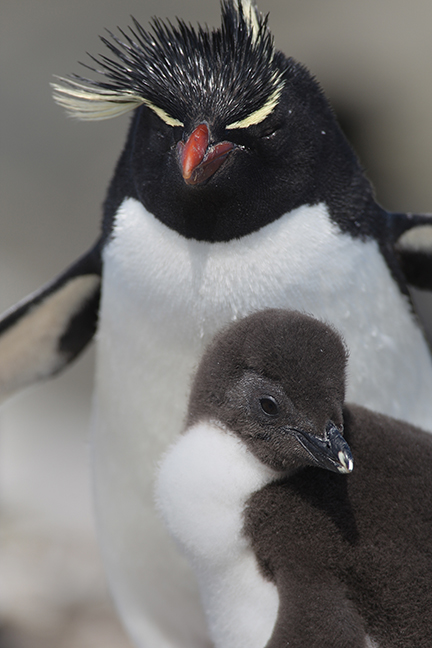

The Falkland Islands (Islas Malvinas) regularly hosts the largest breeding population of Gentoo Penguins in the world, averaging more than 100,000 pairs. They are the second largest Falkland penguin, standing about 30 inches tall. Sea lions are the main predator of adult birds, while Skuas and Striated Caracaras take eggs and chicks. They are inshore foragers and rarely venture more than 12 miles from shore. When raising chicks, they leave their nests at first light and don't return until early evening. (1/3)
©Rich Beckman


The Falkland Islands (Islas Malvinas) regularly hosts the largest breeding population of Gentoo Penguins in the world, averaging more than 100,000 pairs. They are the second largest Falkland penguin, standing about 30 inches tall. Sea lions are the main predator of adult birds, while Skuas and Striated Caracaras take eggs and chicks. They are inshore foragers and rarely venture more than 12 miles from shore. When raising chicks, they leave their nests at first light and don't return until early evening. (2/3)
©Rich Beckman


The Falkland Islands (Islas Malvinas) regularly hosts the largest breeding population of Gentoo Penguins in the world, averaging more than 100,000 pairs. They are the second largest Falkland penguin, standing about 30 inches tall. Sea lions are the main predator of adult birds, while Skuas and Striated Caracaras take eggs and chicks. They are inshore foragers and rarely venture more than 12 miles from shore. When raising chicks, they leave their nests at first light and don't return until early evening. (3/3)
©Rich Beckman


The Volunteer Point colony is the largest breeding group of King Penguins within the Falkland Islands, where they are at the northerly limit of their range. They are the second largest species of penguin, second only to the Emperor Penguin. King Penguins are serially monogamous. They feed their chicks by partially digesting fish and then vomiting the food into their chick's mouth. King Penguins can form huge breeding colonies, in some places numbering over 100,000 pairs. (1/3)
©Rich Beckman


The Volunteer Point colony is the largest breeding group of King Penguins within the Falkland Islands, where they are at the northerly limit of their range. They are the second largest species of penguin, second only to the Emperor Penguin. King Penguins are serially monogamous. They feed their chicks by partially digesting fish and then vomiting the food into their chick's mouth. King Penguins can form huge breeding colonies, in some places numbering over 100,000 pairs. (2/3)
©Rich Beckman


The Volunteer Point colony is the largest breeding group of King Penguins within the Falkland Islands, where they are at the northerly limit of their range. They are the second largest species of penguin, second only to the Emperor Penguin. King Penguins are serially monogamous. They feed their chicks by partially digesting fish and then vomiting the food into their chick's mouth. King Penguins can form huge breeding colonies, in some places numbering over 100,000 pairs. (3/3)
©Rich Beckman


The Southern Rockhopper Penguin is the smallest Falkland penguin. They are migratory, arriving in the islands to breed in early October and leaving by the end of April. Rockhoppers bound—rather than waddle, as most other penguins do—along the craggy, shorelines of the islands. (1/3)
©Rich Beckman


The Southern Rockhopper Penguin is the smallest Falkland penguin. They are migratory, arriving in the islands to breed in early October and leaving by the end of April. Rockhoppers bound—rather than waddle, as most other penguins do—along the craggy, shorelines of the islands. (2/3)
©Rich Beckman


The Southern Rockhopper Penguin is the smallest Falkland penguin. They are migratory, arriving in the islands to breed in early October and leaving by the end of April. Rockhoppers bound—rather than waddle, as most other penguins do—along the craggy, shorelines of the islands. (3/3)
©Rich Beckman